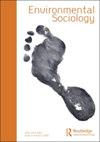Why are there African huts at the zoo? The racialized spectacle of conservation
IF 2.4
Q3 ENVIRONMENTAL STUDIES
引用次数: 0
Abstract
ABSTRACT With 700 million annual global visitors, zoos transmit widely consumed stories about human relationships with nature and animals. In recent decades, zoos have framed their mission around wildlife conservation. Yet just as zoos pivoted to conservation, they simultaneously re-introduced ‘native village’ exhibits: African huts, thatched roofs, and Thai tuktuks. This article examines the Denver Zoo in Colorado, arguing that the zoo produces a racialized spectacle of conservation. Drawing on quantitative and photographic documentation of the zoo’s signage and architecture, I describe how the African and Asian exhibits at the zoo are the only sections representing human culture, and feature elaborate architectures, artwork, and descriptions of stereotypically rural and primitive people. These representations ‘naturalize race’ by portraying these cultures as closer to nature. Zoo exhibits simultaneously reproduce Malthusian narratives of environmental decline, blaming African and Asian populations for harming wildlife through overpopulation, deforestation, and illegal poaching. White Western conservationists are portrayed as educating local tribes in proper beliefs and scientific management. Meanwhile, exhibits erase how colonial exploitation, capitalism, and conservation itself have destabilized human-ecological relationships across the globe. This article contributes to broader literatures on the spectacle of neoliberal global conservation, demonstrating the racialization of this spectacle.为什么动物园里有非洲小屋?种族化的保护奇观
摘要动物园每年有7亿全球游客,传播着人们广泛关注的关于人类与自然和动物关系的故事。近几十年来,动物园围绕野生动物保护制定了自己的使命。然而,就在动物园转向保护的同时,它们也重新引入了“本土村庄”的展品:非洲小屋、茅草屋顶和泰国土克图。这篇文章考察了科罗拉多州的丹佛动物园,认为该动物园创造了一个种族化的保护奇观。根据动物园标志和建筑的定量和摄影文件,我描述了动物园的非洲和亚洲展品是如何成为代表人类文化的唯一部分,并以精心制作的建筑、艺术品和对刻板印象中的农村和原始人的描述为特色。这些表现通过将这些文化描绘成更接近自然而“自然化了种族”。动物园的展品同时再现了马尔萨斯关于环境恶化的叙事,指责非洲和亚洲人口通过人口过剩、森林砍伐和非法偷猎伤害野生动物。西方白人环保主义者被描绘成教育当地部落正确的信仰和科学的管理。与此同时,展品抹去了殖民剥削、资本主义和保护本身是如何破坏全球人类生态关系的。这篇文章为更广泛的关于新自由主义全球保护奇观的文献做出了贡献,展示了这一奇观的种族化。
本文章由计算机程序翻译,如有差异,请以英文原文为准。
求助全文
约1分钟内获得全文
求助全文
来源期刊

Environmental Sociology
ENVIRONMENTAL STUDIES-
CiteScore
4.60
自引率
12.00%
发文量
34
期刊介绍:
Environmental Sociology is dedicated to applying and advancing the sociological imagination in relation to a wide variety of environmental challenges, controversies and issues, at every level from the global to local, from ‘world culture’ to diverse local perspectives. As an international, peer-reviewed scholarly journal, Environmental Sociology aims to stretch the conceptual and theoretical boundaries of both environmental and mainstream sociology, to highlight the relevance of sociological research for environmental policy and management, to disseminate the results of sociological research, and to engage in productive dialogue and debate with other disciplines in the social, natural and ecological sciences. Contributions may utilize a variety of theoretical orientations including, but not restricted to: critical theory, cultural sociology, ecofeminism, ecological modernization, environmental justice, organizational sociology, political ecology, political economy, post-colonial studies, risk theory, social psychology, science and technology studies, globalization, world-systems analysis, and so on. Cross- and transdisciplinary contributions are welcome where they demonstrate a novel attempt to understand social-ecological relationships in a manner that engages with the core concerns of sociology in social relationships, institutions, practices and processes. All methodological approaches in the environmental social sciences – qualitative, quantitative, integrative, spatial, policy analysis, etc. – are welcomed. Environmental Sociology welcomes high-quality submissions from scholars around the world.
 求助内容:
求助内容: 应助结果提醒方式:
应助结果提醒方式:


